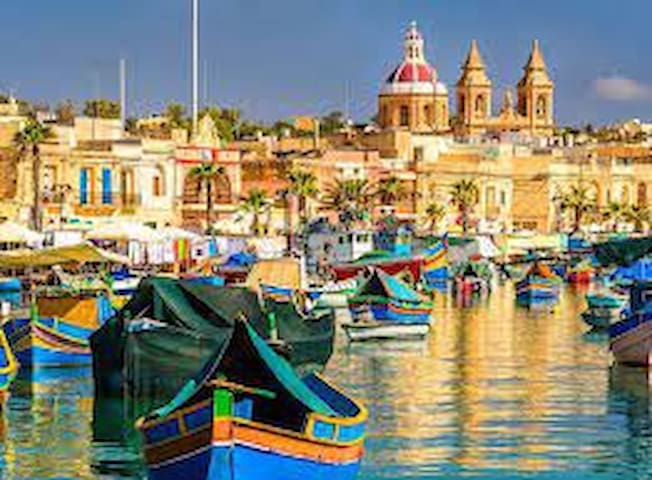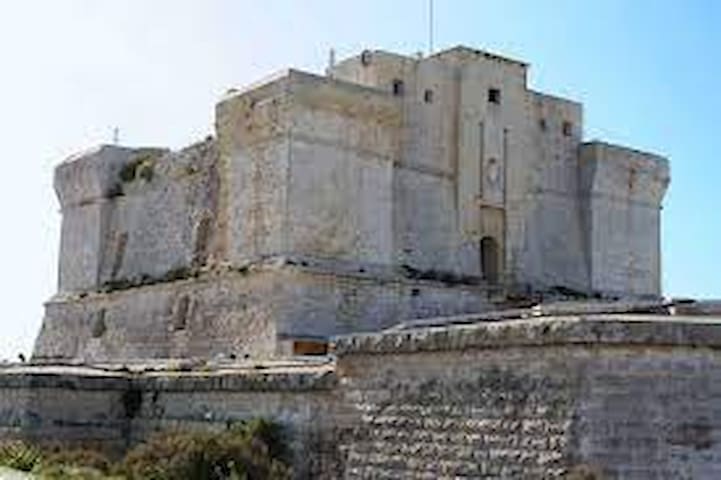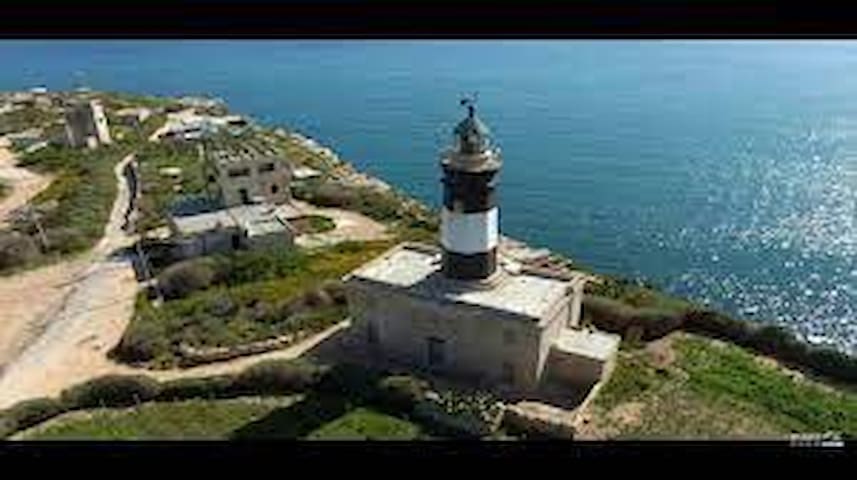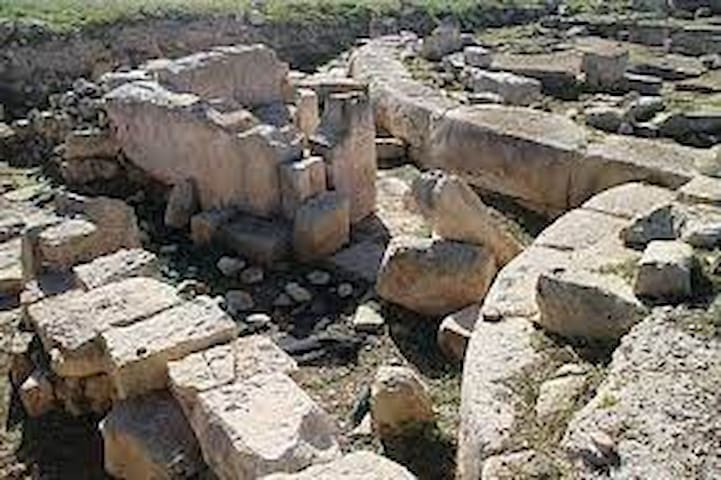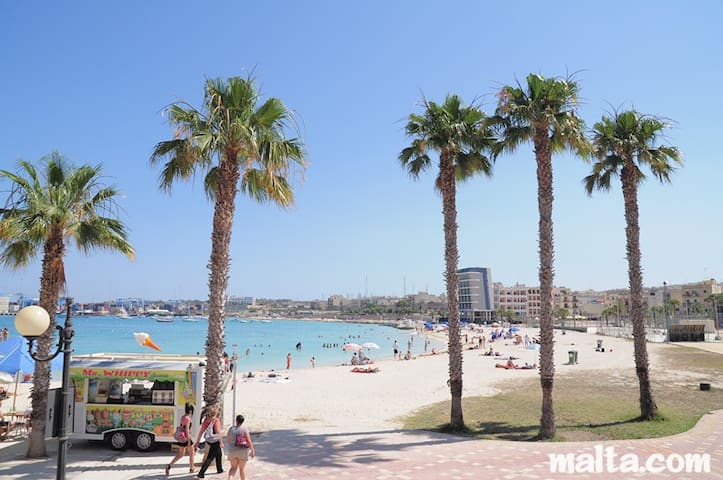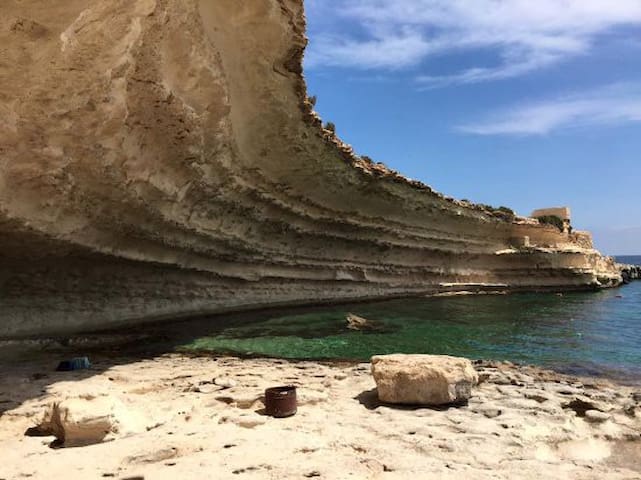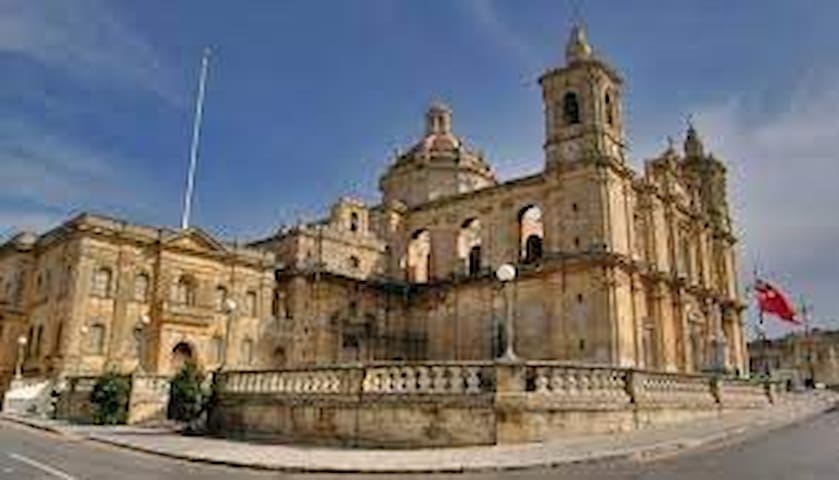City/town information
Marsaxlokk is a small, traditional fishing village in the South Eastern Region of Malta. It has a harbour, and is a tourist attraction known for its views, fishermen and history. The fishing port is located 1 km away from us and can be easily reached easily by walking down the lane or on horseback.
192 vietiniai rekomenduoja
Marsaxlokk
Marsaxlokk is a small, traditional fishing village in the South Eastern Region of Malta. It has a harbour, and is a tourist attraction known for its views, fishermen and history. The fishing port is located 1 km away from us and can be easily reached easily by walking down the lane or on horseback.
Neighborhoods
Marnisi Estate is spread across 73,2 tumoli (20,3 acres) of land owned by Marsovin Estates, with over 50.000 vines planted – consisting of Cabernet Sauvignon, Merlot, Cabernet Franc and Petit Verdot.
The wine is transferred unfiltered to oak barriques and aged for a minimum of 12 months on the estate’s cellars.
You can visit the cellars and enjoy a wine tasting session guided by their staff. The scheduled cellar tours introduce visitors to the process of how the locally grown grapes are pressed, fermented and transformed into wine.
The duration of the tour is approximately 2 hours, taking place once a week from October to April and twice a week from May to September except on public holidays.
Il-Marnisi
Marnisi Estate is spread across 73,2 tumoli (20,3 acres) of land owned by Marsovin Estates, with over 50.000 vines planted – consisting of Cabernet Sauvignon, Merlot, Cabernet Franc and Petit Verdot.
The wine is transferred unfiltered to oak barriques and aged for a minimum of 12 months on the estate’s cellars.
You can visit the cellars and enjoy a wine tasting session guided by their staff. The scheduled cellar tours introduce visitors to the process of how the locally grown grapes are pressed, fermented and transformed into wine.
The duration of the tour is approximately 2 hours, taking place once a week from October to April and twice a week from May to September except on public holidays.
Sightseeing
On the same stretch of land we find the palace of Marnisi a hand some palace. In 1551 Ugolino Bonnici bought the land. On the facade of this palace there is an inscription which says, “In the reign of Grand Master Lascaris, Jacob Testaferrata De Robertis U.I.D on the Marnisi land, bought 100 years ago by Ugolino Bonnici, uncle of his wife Teodora, where once not too far off, giants built the temple in honour of Herculis because of the beautiful surroundings of sky and harbour, he built this villa on 29th October 1650”. In this palace we find the chapel of St. Dominic.
Il-Marnisi
On the same stretch of land we find the palace of Marnisi a hand some palace. In 1551 Ugolino Bonnici bought the land. On the facade of this palace there is an inscription which says, “In the reign of Grand Master Lascaris, Jacob Testaferrata De Robertis U.I.D on the Marnisi land, bought 100 years ago by Ugolino Bonnici, uncle of his wife Teodora, where once not too far off, giants built the temple in honour of Herculis because of the beautiful surroundings of sky and harbour, he built this villa on 29th October 1650”. In this palace we find the chapel of St. Dominic.
Protruding into Marsaxlokk Harbour is a peninsula called Marnizi on which we find a fortified tower. This is St. Lucian’s Tower.
When Grand Master Alofde Wignacourt was ruling, there lived in Malta a certain slave called “Katrin is-Sewda” (sewda means black). She hailed from Tunisia, became a Christian and was known as a very pious woman. She claimed that she had a vision in which St. John told her to advice the Grand Master to fortify the harbour of Marsaxlokk because of an attack which the Turks were planning for the summer. Her spiritual director immediately informed Bishop Garagallo, but the Grand Master didn’t heed this advice.
In summer the Turks really did come and so the Grandmaster found how mistaken he was. Then Wignacourt took immediate action and a ban was issued on 1st July 1610 and the construction of the Tower began at once. It was called St. Lucian because Wignacourt was baptised in St. Lucian’s church in his home town in France.
This tower has a square shape with very thick walls. (Some say that it was designed by Victor Cassar). Its construction was completed in 1611 and Grand Master Wignacourt went with a number of knights on board the ‘Kaptan’ and ‘Padruna’ so as to oversee the stationing of all the six bronze cannon and fortified it with arms and monition.
In the tower there was a small chapel dedicated to St. Lucian. Much later when it was partly abandoned the picture depicting St. Lucian found itself at Tarxien Parish Church.The moat which surrounded it and the drawbridge made it more impregnable. In 1876, Governor Straubensee spent Lm9000 on its maintenance. Later the tower passed in the hands of the Maltese artillery.
In 1795 a ban was issued by which the tower was called “Fort Rohan” as suggests the inscription on it. This tower played its part in the 2nd World War, then sadly it was discarded. Between 1972 / 73 the Government passed it to the University to set up in it a Biological Laboratory. For this aim the Barclays Bank Development Fund Donated the sum of Lm30,000 for its refurbishment. After years of work on Saturday 31st May 1975, Dr. Joseph Cassar, Minister of Education inaugurated this project.
St. Lucian's Tower
Triq Il-QajjenzaProtruding into Marsaxlokk Harbour is a peninsula called Marnizi on which we find a fortified tower. This is St. Lucian’s Tower.
When Grand Master Alofde Wignacourt was ruling, there lived in Malta a certain slave called “Katrin is-Sewda” (sewda means black). She hailed from Tunisia, became a Christian and was known as a very pious woman. She claimed that she had a vision in which St. John told her to advice the Grand Master to fortify the harbour of Marsaxlokk because of an attack which the Turks were planning for the summer. Her spiritual director immediately informed Bishop Garagallo, but the Grand Master didn’t heed this advice.
In summer the Turks really did come and so the Grandmaster found how mistaken he was. Then Wignacourt took immediate action and a ban was issued on 1st July 1610 and the construction of the Tower began at once. It was called St. Lucian because Wignacourt was baptised in St. Lucian’s church in his home town in France.
This tower has a square shape with very thick walls. (Some say that it was designed by Victor Cassar). Its construction was completed in 1611 and Grand Master Wignacourt went with a number of knights on board the ‘Kaptan’ and ‘Padruna’ so as to oversee the stationing of all the six bronze cannon and fortified it with arms and monition.
In the tower there was a small chapel dedicated to St. Lucian. Much later when it was partly abandoned the picture depicting St. Lucian found itself at Tarxien Parish Church.The moat which surrounded it and the drawbridge made it more impregnable. In 1876, Governor Straubensee spent Lm9000 on its maintenance. Later the tower passed in the hands of the Maltese artillery.
In 1795 a ban was issued by which the tower was called “Fort Rohan” as suggests the inscription on it. This tower played its part in the 2nd World War, then sadly it was discarded. Between 1972 / 73 the Government passed it to the University to set up in it a Biological Laboratory. For this aim the Barclays Bank Development Fund Donated the sum of Lm30,000 for its refurbishment. After years of work on Saturday 31st May 1975, Dr. Joseph Cassar, Minister of Education inaugurated this project.
l-Bajja ta’ Marsaxlokk is a bay and is located in Birżebbuġa, Malta. The estimate terrain elevation above seal level is 1 metres. Variant forms of spelling for Il-Bajja ta’ Marsaxlokk or in other languages: Ir-Ramla ta Marsaxlokk, Marsa Shlok, Marsa Sirocco, Marsaxlokk Bay, Baia Marsa Scirocco, Marsaxlokk, Marsa Scirocco, Marsa Soirocco Bay, Il-Bajja ta’ Marsaxlokk, Baia Marsa Scirocco, Il-Bajja ta' Marsaxlokk, Il-Bajja ta’ Marsaxlokk, Ir-Ramla ta Marsaxlokk, Marsa Scirocco, Marsa Shlok, Marsa Sirocco, Marsa Soirocco Bay, Marsaxlokk, Marsaxlokk Bay.
Il-Bajja ta' Marsaxlokk
l-Bajja ta’ Marsaxlokk is a bay and is located in Birżebbuġa, Malta. The estimate terrain elevation above seal level is 1 metres. Variant forms of spelling for Il-Bajja ta’ Marsaxlokk or in other languages: Ir-Ramla ta Marsaxlokk, Marsa Shlok, Marsa Sirocco, Marsaxlokk Bay, Baia Marsa Scirocco, Marsaxlokk, Marsa Scirocco, Marsa Soirocco Bay, Il-Bajja ta’ Marsaxlokk, Baia Marsa Scirocco, Il-Bajja ta' Marsaxlokk, Il-Bajja ta’ Marsaxlokk, Ir-Ramla ta Marsaxlokk, Marsa Scirocco, Marsa Shlok, Marsa Sirocco, Marsa Soirocco Bay, Marsaxlokk, Marsaxlokk Bay.
The first fortress was built at Delimara in 1880. Its construction took five years. It had a rolling bridge and was furnished with six cannon and cost Lm18,000.
Delimara Lighthouse
The first fortress was built at Delimara in 1880. Its construction took five years. It had a rolling bridge and was furnished with six cannon and cost Lm18,000.
St. Peter's Pool 3.5 km away and easly reach on horseback is a beautiful natural pool ideal to spend a relaxing day away from the busy tourists spots
St. Peter’s Pool is one of the most beautiful and stunning natural swimming pools in Malta and is located close to Marsaxlokk at the tip of Delimara Point in the southwest of Malta.
The sea at St. Peters Pool is crystal clear with an amazing azure and light green colors and offers excellent snorkelling opportunities. The flat rocks around St Peter’s Pool provide perfect sunbathing areas and the high rocks offer some shade from the strong sun.
Ladders are available to access the sea and the more adventurous bathers have the option of diving into the waters from a few meters up. St. Peter’s Pool is popular with the locals, especially for those living in nearby villages and with tourists who are looking for a quieter place to spend their day. However, due to its remote location and bad roads leading there it’s rarely ever crowded and you can always find a spot just for yourself.
Make sure that you bring whatever you need for a day out as there are no facilities whatsoever. This natural swimming pool is may not suitable for small children at all times and can have rubbish floating around in it on windy days. Nevertheless, stunning St. Peter’s Pool is a real treat for those looking for a special spot out of the busy tourist areas.
Parking: There is parking on top of the cliff, but the road leading there is very bad. Parking by the main road is recommended.
Recommended for children: If confident in swimming
115 vietiniai rekomenduoja
St. Peter’s Pool
St. Peter's Pool 3.5 km away and easly reach on horseback is a beautiful natural pool ideal to spend a relaxing day away from the busy tourists spots
St. Peter’s Pool is one of the most beautiful and stunning natural swimming pools in Malta and is located close to Marsaxlokk at the tip of Delimara Point in the southwest of Malta.
The sea at St. Peters Pool is crystal clear with an amazing azure and light green colors and offers excellent snorkelling opportunities. The flat rocks around St Peter’s Pool provide perfect sunbathing areas and the high rocks offer some shade from the strong sun.
Ladders are available to access the sea and the more adventurous bathers have the option of diving into the waters from a few meters up. St. Peter’s Pool is popular with the locals, especially for those living in nearby villages and with tourists who are looking for a quieter place to spend their day. However, due to its remote location and bad roads leading there it’s rarely ever crowded and you can always find a spot just for yourself.
Make sure that you bring whatever you need for a day out as there are no facilities whatsoever. This natural swimming pool is may not suitable for small children at all times and can have rubbish floating around in it on windy days. Nevertheless, stunning St. Peter’s Pool is a real treat for those looking for a special spot out of the busy tourist areas.
Parking: There is parking on top of the cliff, but the road leading there is very bad. Parking by the main road is recommended.
Recommended for children: If confident in swimming
Tas-Silġ is a rounded hilltop on the south-east coast of the island of Malta, overlooking Marsaxlokk Bay, and close to our place. Tas-Silġ is a major multi-period sanctuary site with archaeological remains covering four thousand years, from the neolithic to the ninth century AD.] The site includes a megalithic temple complex dating from the early third millennium BC, to a Phoenician and Punic sanctuary dedicated to the goddess Astarte.[3] During the Roman era, the site became an international religious complex dedicated to the goddess Juno, helped by its location along major maritime trading routes, with the site being mentioned by first-century BC orator Cicero.[3]
Church of Our Lady of tas-Silg
Triq DelimaraTas-Silġ is a rounded hilltop on the south-east coast of the island of Malta, overlooking Marsaxlokk Bay, and close to our place. Tas-Silġ is a major multi-period sanctuary site with archaeological remains covering four thousand years, from the neolithic to the ninth century AD.] The site includes a megalithic temple complex dating from the early third millennium BC, to a Phoenician and Punic sanctuary dedicated to the goddess Astarte.[3] During the Roman era, the site became an international religious complex dedicated to the goddess Juno, helped by its location along major maritime trading routes, with the site being mentioned by first-century BC orator Cicero.[3]
Pretty Bay which can be reached on horseback in 30 minutes is one of the sandy beaches in the South of Malta which is very popular with the locals during the summer season
Pretty Bay is located in Birzebbuga in the Southern part of Malta and is a man-made large sandy beach. The build-up and the buildings around the beach give Pretty Bay a special charm. Even though the bay is artificially filled with sand, it is quite nice. However, the beaches in the northern part of Malta are more recommended if you are after a sandy beach. Around Pretty Bay there are plenty of cafes, bars and restaurants along the shore and it is very popular with the Maltese.
Many locals have summerhouses by Pretty Bay and move there during the summer months. Pretty Bay has a football pitch, a playground for the children and it tends to get crowded during the weekends in the summertime. In the evening, the promenade is a popular place to take a walk. The negative point about Pretty Bay is that the Malta International Freeport is strongly disturbing the view. However, if you visit Pretty Bay don’t forget to stop by the Ghar Dalam - the Cave of Darkness which has semi-fossilized remains dating back over 250,000 years!
40 vietiniai rekomenduoja
Pretty Bay
Pretty Bay which can be reached on horseback in 30 minutes is one of the sandy beaches in the South of Malta which is very popular with the locals during the summer season
Pretty Bay is located in Birzebbuga in the Southern part of Malta and is a man-made large sandy beach. The build-up and the buildings around the beach give Pretty Bay a special charm. Even though the bay is artificially filled with sand, it is quite nice. However, the beaches in the northern part of Malta are more recommended if you are after a sandy beach. Around Pretty Bay there are plenty of cafes, bars and restaurants along the shore and it is very popular with the Maltese.
Many locals have summerhouses by Pretty Bay and move there during the summer months. Pretty Bay has a football pitch, a playground for the children and it tends to get crowded during the weekends in the summertime. In the evening, the promenade is a popular place to take a walk. The negative point about Pretty Bay is that the Malta International Freeport is strongly disturbing the view. However, if you visit Pretty Bay don’t forget to stop by the Ghar Dalam - the Cave of Darkness which has semi-fossilized remains dating back over 250,000 years!
Xrobb l-Ghagin
The Church of St Catherine, Żejtun, is a Roman Catholic church, the seat of the archpriest of Żejtun and the mother church of various parishes established from the originally larger territory of the Żejtun
Triq Santa Katarina
Triq Santa KatarinaThe Church of St Catherine, Żejtun, is a Roman Catholic church, the seat of the archpriest of Żejtun and the mother church of various parishes established from the originally larger territory of the Żejtun

